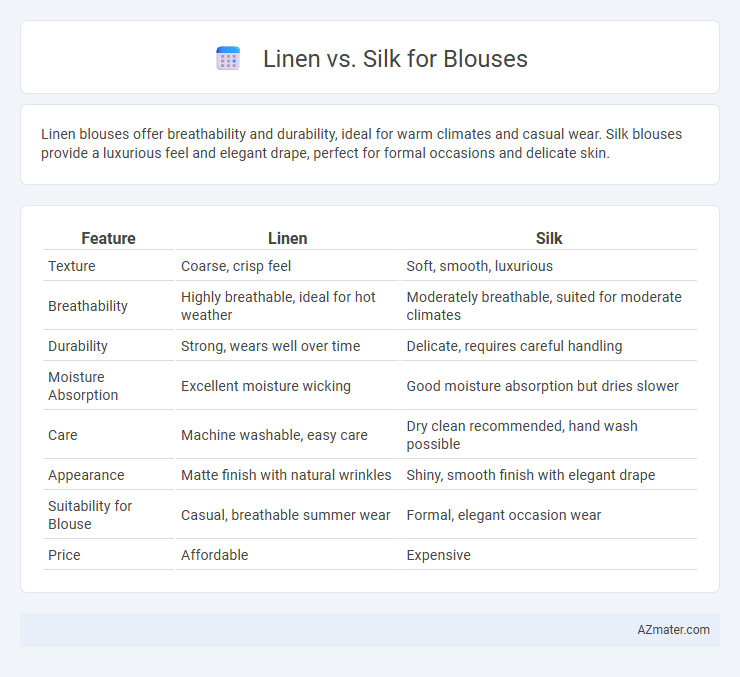Linen blouses offer breathability and durability, ideal for warm climates and casual wear. Silk blouses provide a luxurious feel and elegant drape, perfect for formal occasions and delicate skin.
Table of Comparison
| Feature | Linen | Silk |
|---|---|---|
| Texture | Coarse, crisp feel | Soft, smooth, luxurious |
| Breathability | Highly breathable, ideal for hot weather | Moderately breathable, suited for moderate climates |
| Durability | Strong, wears well over time | Delicate, requires careful handling |
| Moisture Absorption | Excellent moisture wicking | Good moisture absorption but dries slower |
| Care | Machine washable, easy care | Dry clean recommended, hand wash possible |
| Appearance | Matte finish with natural wrinkles | Shiny, smooth finish with elegant drape |
| Suitability for Blouse | Casual, breathable summer wear | Formal, elegant occasion wear |
| Price | Affordable | Expensive |
Introduction: Linen vs Silk for Blouses
Linen and silk are two popular fabrics for blouses, each offering unique qualities that suit different preferences and occasions. Linen is prized for its breathability, moisture-wicking properties, and durability, making it ideal for warm weather and casual to semi-formal wear. Silk is valued for its smooth texture, natural sheen, and luxurious feel, often chosen for elegant, formal blouses that provide comfort and style.
Fabric Overview: What is Linen?
Linen is a natural fabric made from the fibers of the flax plant, known for its exceptional breathability and moisture-wicking properties. It offers a crisp, textured feel that becomes softer with each wash, making it ideal for lightweight and durable blouses. Linen's hypoallergenic and environmentally friendly qualities contribute to its popularity in sustainable fashion choices.
Fabric Overview: What is Silk?
Silk is a natural protein fiber produced by silkworms, renowned for its smooth texture, lustrous appearance, and strong yet lightweight properties. This luxurious fabric offers excellent breathability and moisture-wicking abilities, making it ideal for blouses that require softness and comfort against the skin. Its natural sheen and drape contribute to an elegant silhouette, distinguishing silk from other fabrics like linen.
Comfort and Wearability Comparison
Linen blouses offer superior breathability and moisture-wicking properties, making them ideal for hot and humid climates due to their lightweight and airy texture. Silk blouses provide a smooth, soft feel with natural temperature regulation but tend to be less durable and require more delicate care, impacting everyday wearability. Comfort in linen is enhanced by its ability to keep the skin cool and dry, while silk's luxurious feel excels in formal settings, though it may trap heat and show sweat more easily.
Breathability and Temperature Regulation
Linen offers superior breathability due to its natural fiber structure, allowing air to flow freely and keeping the body cool in hot weather. Silk, while luxurious and smooth, provides moderate temperature regulation by adapting to body heat but retains more heat compared to linen. For blouses aimed at maximum comfort in warm climates, linen's ability to wick moisture and enhance airflow makes it a preferred choice over silk.
Style and Appearance Differences
Linen blouses offer a natural, textured appearance with a slightly matte finish, giving a casual, breathable style ideal for warm weather and relaxed settings. Silk blouses provide a smooth, glossy surface with a luxurious sheen that enhances elegance and sophistication, making them perfect for formal or evening wear. The drape of silk is fluid and soft, contrasting with linen's stiffer, structured fit, which influences the overall silhouette and perceived formality.
Durability and Maintenance Needs
Linen blouses offer superior durability due to their strong, natural fibers that withstand frequent washing and wear, making them ideal for everyday use. Silk blouses, while luxurious and soft, require delicate handling and specialized care such as dry cleaning or gentle hand washing to maintain their texture and prevent damage. The maintenance needs of silk are higher, with sensitivity to moisture and abrasion, whereas linen benefits from easier laundering and enhanced longevity.
Eco-Friendliness and Sustainability
Linen, derived from flax plants, is highly eco-friendly due to its low water usage, biodegradable fibers, and minimal pesticide requirement, making it a sustainable choice for blouses. Silk production, while natural, often involves resource-intensive sericulture and energy consumption, raising sustainability concerns despite its biodegradability. Choosing linen blouses supports sustainable fashion through renewable resources and reduced environmental impact compared to silk alternatives.
Price Point and Value for Money
Linen blouses typically offer a lower price point compared to silk, making them a more budget-friendly option without compromising breathability and durability. Silk blouses, while more expensive, provide superior softness, elegance, and natural sheen, enhancing the garment's luxury appeal and long-term value. The choice between linen and silk depends on balancing initial cost against desired texture and longevity, with linen excelling in affordability and silk in premium quality.
Choosing the Best Fabric: Linen or Silk?
Linen offers superior breathability and moisture-wicking properties, making it ideal for warm climates and casual wear, while silk provides a luxurious sheen and smooth texture suited for formal occasions. Linen's durability and natural fiber content contribute to its eco-friendly appeal, whereas silk excels in drape and elegance but requires more delicate care. Choosing between linen and silk depends on lifestyle preferences, climate, and the desired balance between comfort and sophistication in a blouse.

Infographic: Linen vs Silk for Blouse
 azmater.com
azmater.com